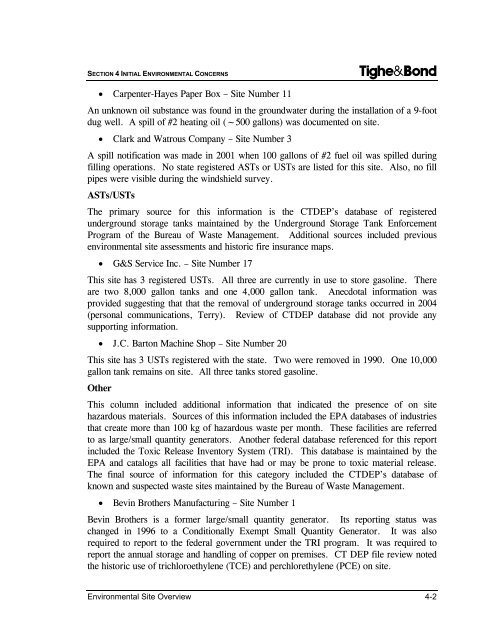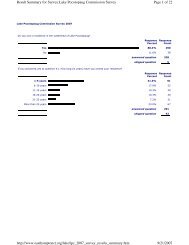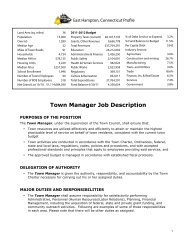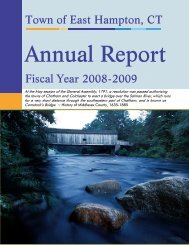Environmental Site Overview - East Hampton, Connecticut
Environmental Site Overview - East Hampton, Connecticut
Environmental Site Overview - East Hampton, Connecticut
Create successful ePaper yourself
Turn your PDF publications into a flip-book with our unique Google optimized e-Paper software.
SECTION 4 INITIAL ENVIRONMENTAL CONCERNS<br />
Tighe&Bond<br />
• Carpenter-Hayes Paper Box – <strong>Site</strong> Number 11<br />
An unknown oil substance was found in the groundwater during the installation of a 9-foot<br />
dug well. A spill of #2 heating oil (~500 gallons) was documented on site.<br />
• Clark and Watrous Company – <strong>Site</strong> Number 3<br />
A spill notification was made in 2001 when 100 gallons of #2 fuel oil was spilled during<br />
filling operations. No state registered ASTs or USTs are listed for this site. Also, no fill<br />
pipes were visible during the windshield survey.<br />
ASTs/USTs<br />
The primary source for this information is the CTDEP’s database of registered<br />
underground storage tanks maintained by the Underground Storage Tank Enforcement<br />
Program of the Bureau of Waste Management. Additional sources included previous<br />
environmental site assessments and historic fire insurance maps.<br />
• G&S Service Inc. – <strong>Site</strong> Number 17<br />
This site has 3 registered USTs. All three are currently in use to store gasoline. There<br />
are two 8,000 gallon tanks and one 4,000 gallon tank. Anecdotal information was<br />
provided suggesting that that the removal of underground storage tanks occurred in 2004<br />
(personal communications, Terry). Review of CTDEP database did not provide any<br />
supporting information.<br />
• J.C. Barton Machine Shop – <strong>Site</strong> Number 20<br />
This site has 3 USTs registered with the state. Two were removed in 1990. One 10,000<br />
gallon tank remains on site. All three tanks stored gasoline.<br />
Other<br />
This column included additional information that indicated the presence of on site<br />
hazardous materials. Sources of this information included the EPA databases of industries<br />
that create more than 100 kg of hazardous waste per month. These facilities are referred<br />
to as large/small quantity generators. Another federal database referenced for this report<br />
included the Toxic Release Inventory System (TRI). This database is maintained by the<br />
EPA and catalogs all facilities that have had or may be prone to toxic material release.<br />
The final source of information for this category included the CTDEP’s database of<br />
known and suspected waste sites maintained by the Bureau of Waste Management.<br />
• Bevin Brothers Manufacturing – <strong>Site</strong> Number 1<br />
Bevin Brothers is a former large/small quantity generator. Its reporting status was<br />
changed in 1996 to a Conditionally Exempt Small Quantity Generator. It was also<br />
required to report to the federal government under the TRI program. It was required to<br />
report the annual storage and handling of copper on premises. CT DEP file review noted<br />
the historic use of trichloroethylene (TCE) and perchlorethylene (PCE) on site.<br />
<strong>Environmental</strong> <strong>Site</strong> <strong>Overview</strong> 4-2







